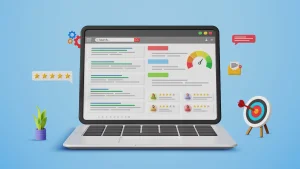What Is Core Web Vitals SEO and Why It Matters
Core Web Vitals SEO focuses on improving three Google benchmarks: LCP (loading), CLS (visual stability), and INP (interactivity). Each metric tracks a different aspect of perceived performance and usability, and together they shape your site speed experience.
Google uses these signals to evaluate page experience, which influences rankings and user engagement. Faster, more stable pages reduce bounce rates and increase conversions, especially on mobile where network limitations magnify performance issues.
- LCP: Aim for ≤2.5 seconds for the main content to appear.
- CLS: Keep layout shifts ≤0.1 to prevent content “jumping.”
- INP: Target ≤200 ms for responsive interactions.
In one retail case study, a 0.1-second improvement in mobile page speed correlated with uplift in conversion rate and average order value—echoing broader findings that performance wins often translate into revenue gains. For technical definitions and thresholds, see Google’s overview of the metrics on web.dev.
How to Audit Core Web Vitals for SEO Wins
Before you improve site speed, measure it. A great Core Web Vitals SEO process pairs field data with lab diagnostics. Field data reflects real users, devices, and networks; lab data helps you reproduce and debug problems in a controlled environment.
- Check field data: Use PageSpeed Insights or Search Console’s Core Web Vitals report to see real-user performance and affected URLs.
- Run lab tests: Use Lighthouse and WebPageTest to isolate bottlenecks and quantify how changes may improve LCP, CLS, and INP.
- Instrument RUM: Add a Real User Monitoring tool to track site speed over time by country, device, and page template.
- Map templates to metrics: Group URLs by template (product pages, blog posts, category pages) to spot systemic issues.
Document baselines and create a prioritized backlog with expected impact, effort, and owners. This turns Core Web Vitals SEO from an ad-hoc fix list into an ongoing performance program.
Best Must-Have Site Speed Boosts for LCP
Improving LCP is usually the highest-ROI step in Core Web Vitals SEO because the main content’s loading speed drives first impressions and engagement. Focus on reducing server time, optimizing critical assets, and eliminating render-blocking resources.
Prioritize the Hero Element
Identify the LCP element—often a hero image or heading—and make it load as early as possible. Inline critical CSS for above-the-fold content and preload the LCP image or font to cut delays.
- Preload: Use link rel=”preload” for the LCP image and web fonts.
- Compress images: Serve AVIF/WebP; resize to exact display dimensions.
- Inline critical CSS: Keep it under ~14 KB; defer the rest.
Kill Render-Blocking Resources
Blocking CSS and synchronous JavaScript delay the first paint and the LCP. Split bundles and load non-critical scripts asynchronously or with defer.
- Defer JS: Add defer to non-critical scripts; lazy-load below-the-fold widgets.
- Minify & tree-shake: Remove dead code, unused libraries, and redundant polyfills.
- Reduce third parties: Audit tags; replace heavy trackers with server-side implementations where possible.
Speed Up the Server
Server and network latency often dominate LCP. Use a production-grade stack with modern protocols and caching.
- CDN everything: Cache HTML when safe; always cache static assets.
- HTTP/2 or HTTP/3: Multiplexing and improved congestion control reduce head-of-line blocking.
- Edge rendering: Move critical route rendering to the edge; use stale-while-revalidate for resilience.
CLS Stability Fixes That Stick
CLS impacts perceived quality and trust. Sudden layout shifts frustrate users and can tank conversions. For Core Web Vitals SEO, these site speed stability fixes are non-negotiable.
- Always set width and height: Reserve space for images, iframes, and ads; use CSS aspect-ratio for responsive placeholders.
- Avoid late-injected UI: Don’t push content down with banners or consent dialogs after initial render.
- Font strategy: Use font-display: optional or swap to prevent FOIT; preload critical fonts to reduce FOUT jank.
- Skeletons, not pop-ins: Display skeleton screens where content will appear rather than inserting new blocks later.
- Stabilize ads/components: Provide fixed containers and fallback content to avoid push-downs.
Track CLS at a component level across templates. Often, one misplaced ad slot or dynamic header causes the majority of shifts.
INP: Make Interactions Feel Instant
INP measures how long it takes a page to respond to interactions like taps and clicks. Improving INP is central to Core Web Vitals SEO on JavaScript-heavy sites, where main-thread blocking is common.
- Break up long tasks: Split heavy functions into smaller chunks using requestIdleCallback or yielding to the main thread.
- Hydration on demand: Use partial/Island hydration or server components to limit JS on the main thread.
- Optimize event handlers: Debounce expensive listeners; remove passive=false touch listeners unless required.
- Prefetch routes: Predictive prefetching for likely next pages reduces perceived delay.
- Web workers: Move expensive computations off the main thread.
Measure with the Event Timing API in RUM. Sometimes a single misconfigured handler on a global nav drives most of your INP regressions.
Image, Font, and Video Tactics That Turbocharge Site Speed
Media optimization multiplies the benefits of other Core Web Vitals SEO work. Images and fonts are among the heaviest resources on most sites.
Images
- Next-gen formats: AVIF and WebP reduce size 20–50% versus JPEG/PNG.
- Responsive srcset/sizes: Serve the right resolution per viewport; avoid sending desktop assets to mobile.
- Lazy-load below the fold: native loading=”lazy” with proper thresholds to avoid LCP delays.
Fonts
- Subset fonts: Include only used glyphs; host fonts locally for caching control.
- Preload critical fonts: Prevent late swaps; keep total font weight minimal.
- System font stacks: Consider system fonts for critical UI to minimize CLS and improve site speed.
Video
- Poster images: Don’t autoplay above-the-fold video; use lightweight poster images instead.
- Facades for embeds: Replace heavy iframes (e.g., YouTube) with click-to-load facades.
- Adaptive streaming: Use HLS/DASH for long-form video; defer loading player JS until interaction.
Technical Foundations: Caching, Compression, and Delivery
Behind every great Core Web Vitals SEO result is a well-tuned platform. Get these fundamentals right and everything else compounds.
- Caching: Use long-lived immutable caching for static assets; implement cache-busting via hashed filenames.
- Compression: Enable Brotli level 5–7 for text-based assets; ensure gzip fallback for older clients.
- Preconnect & DNS-prefetch: Hint early connections to critical origins (CDN, fonts, APIs).
- Server-side rendering: SSR reduces time-to-first-byte and stabilizes LCP; pair with streaming for faster first paint.
- API performance: Batch requests, cache responses at the edge, and reduce chatty client-server round trips.
Regularly profile back-end response times. High TTFB often signals database bottlenecks, lack of caching, or N+1 query patterns.
Prioritization Framework: Fast Wins vs. Strategic Fixes
Not all site speed improvements deliver equal impact. Use this prioritization model to make Core Web Vitals SEO changes stick:
- Fix regressions first: Patch recent changes that worsened LCP, CLS, or INP.
- High-impact, low-effort: Preload LCP image, inline critical CSS, set image dimensions, defer non-critical JS.
- Medium effort, durable gains: Implement font subsetting, route-level code splitting, and CDN caching rules.
- Strategic refactors: Adopt island architecture, move to HTTP/3, migrate to image CDNs with on-the-fly optimization.
Tie each item to a KPI: percentage of URLs in “Good” status, median LCP target, or conversion rate. Report progress monthly to maintain momentum.
Case Study Snapshots: Results You Can Replicate
These examples illustrate how Core Web Vitals SEO improvements cascade into business outcomes:
- Ecommerce LCP overhaul: Preloading hero images and trimming render-blocking JS cut LCP from 3.8s to 2.1s on mobile, lifting organic revenue 9% over eight weeks.
- News site CLS fix: Reserving ad slots and preloading fonts reduced CLS from 0.29 to 0.06, improving pages-per-session 12%.
- SaaS INP focus: Splitting long tasks and adding route prefetching reduced INP from 380ms to 160ms, raising free-trial sign-ups 6%.
Your mileage will vary, but the principle holds: optimize for humans first; rankings and revenue follow.
Toolbox: Measure, Monitor, and Maintain
A solid Core Web Vitals SEO workflow requires continuous measurement and alerting. Set up a stack that blends field and lab insights.
- Google Search Console: Track CWV coverage and template-level issues over time.
- PageSpeed Insights / Lighthouse: Diagnose opportunities and validate improvements.
- WebPageTest: Visualize waterfalls and quantify savings from preloading, compression, and caching.
- RUM platform: Capture user-centric metrics across regions and devices; set alerts for regressions in LCP, CLS, and INP.
- CI/CD Performance Budgets: Block merges that violate site speed thresholds or increase JS/asset weight beyond budgets.
Automate as much as possible. Performance that depends on manual checks will regress.
Common Pitfalls That Hurt Core Web Vitals
Even well-intentioned optimization efforts can backfire. Avoid these traps:
- Over-optimizing images without dimensions → Causes CLS spikes when the browser recalculates layout.
- Too much JS deferral → Deferring essential scripts (like navigation) can delay interactivity and hurt INP.
- Caching without invalidation → Users may see stale or broken pages if cache purge rules aren’t automated.
- Font mismanagement → Loading large custom fonts without preloading or subsetting leads to layout jank and slow first paint.
- Chasing lab scores only → Always balance Lighthouse improvements with field data (real-user experience).
The key is consistency. Core Web Vitals SEO is not a “one-and-done” project—it’s an ongoing program that requires monitoring, ownership, and governance across marketing and development teams.
Key Takeaways
- Core Web Vitals drive SEO and revenue: LCP, CLS, and INP directly affect rankings, engagement, and conversions.
- Audit with both field and lab data: Pair RUM (real users) with Lighthouse/WebPageTest for actionable insights.
- Prioritize high-ROI fixes: Preload hero images, stabilize layouts, and reduce main-thread blocking JS first.
- Invest in durable solutions: CDN caching, modern protocols (HTTP/3, Brotli), and architecture changes like island hydration.
- Make it ongoing: Track regressions with alerts, enforce budgets in CI/CD, and align stakeholders on performance KPIs.
Core Web Vitals SEO isn’t about chasing green scores—it’s about building fast, stable, and delightful websites that earn trust, rank higher, and convert more.



